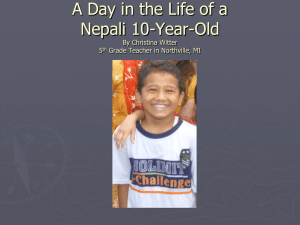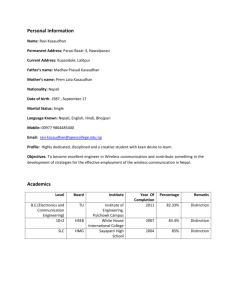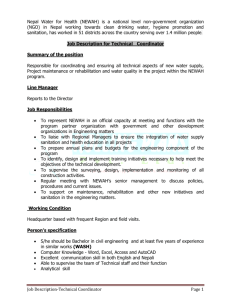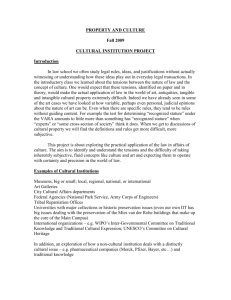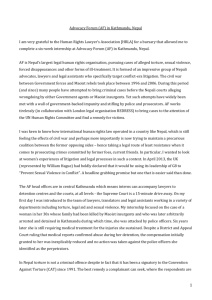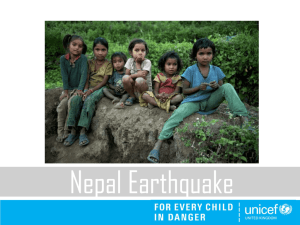Rescue, Recovery, Repatriation and Integration of Nepali Survivors
advertisement
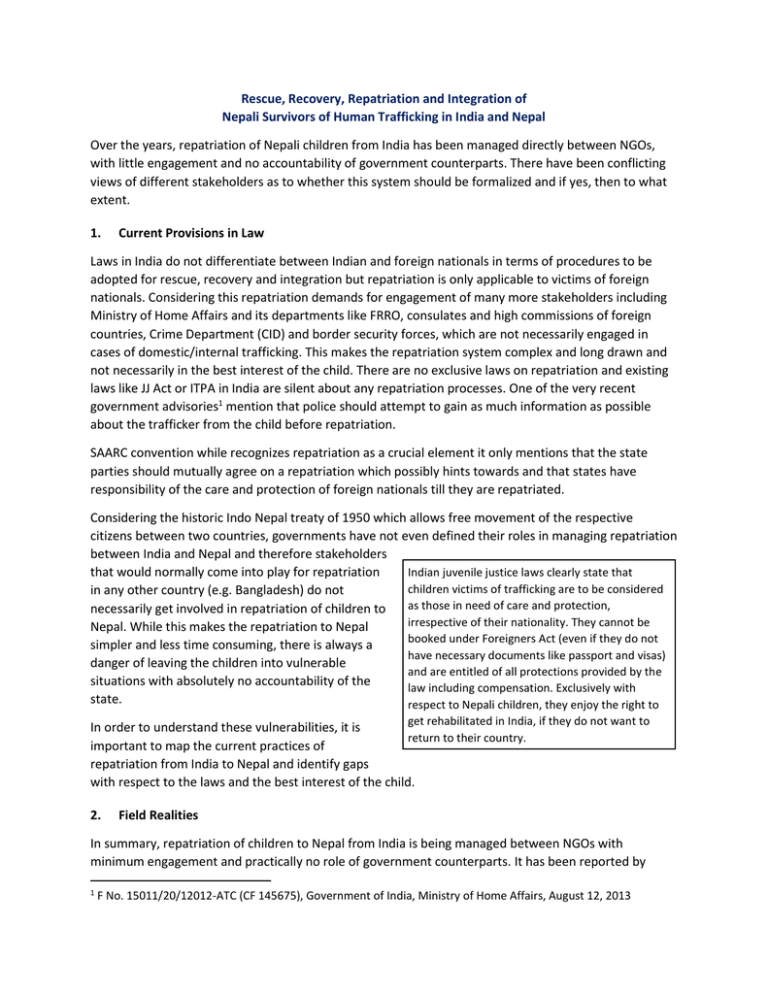
Rescue, Recovery, Repatriation and Integration of Nepali Survivors of Human Trafficking in India and Nepal Over the years, repatriation of Nepali children from India has been managed directly between NGOs, with little engagement and no accountability of government counterparts. There have been conflicting views of different stakeholders as to whether this system should be formalized and if yes, then to what extent. 1. Current Provisions in Law Laws in India do not differentiate between Indian and foreign nationals in terms of procedures to be adopted for rescue, recovery and integration but repatriation is only applicable to victims of foreign nationals. Considering this repatriation demands for engagement of many more stakeholders including Ministry of Home Affairs and its departments like FRRO, consulates and high commissions of foreign countries, Crime Department (CID) and border security forces, which are not necessarily engaged in cases of domestic/internal trafficking. This makes the repatriation system complex and long drawn and not necessarily in the best interest of the child. There are no exclusive laws on repatriation and existing laws like JJ Act or ITPA in India are silent about any repatriation processes. One of the very recent government advisories1 mention that police should attempt to gain as much information as possible about the trafficker from the child before repatriation. SAARC convention while recognizes repatriation as a crucial element it only mentions that the state parties should mutually agree on a repatriation which possibly hints towards and that states have responsibility of the care and protection of foreign nationals till they are repatriated. Considering the historic Indo Nepal treaty of 1950 which allows free movement of the respective citizens between two countries, governments have not even defined their roles in managing repatriation between India and Nepal and therefore stakeholders that would normally come into play for repatriation Indian juvenile justice laws clearly state that children victims of trafficking are to be considered in any other country (e.g. Bangladesh) do not as those in need of care and protection, necessarily get involved in repatriation of children to irrespective of their nationality. They cannot be Nepal. While this makes the repatriation to Nepal booked under Foreigners Act (even if they do not simpler and less time consuming, there is always a have necessary documents like passport and visas) danger of leaving the children into vulnerable and are entitled of all protections provided by the situations with absolutely no accountability of the law including compensation. Exclusively with state. respect to Nepali children, they enjoy the right to get rehabilitated in India, if they do not want to In order to understand these vulnerabilities, it is return to their country. important to map the current practices of repatriation from India to Nepal and identify gaps with respect to the laws and the best interest of the child. 2. Field Realities In summary, repatriation of children to Nepal from India is being managed between NGOs with minimum engagement and practically no role of government counterparts. It has been reported by 1 F No. 15011/20/12012-ATC (CF 145675), Government of India, Ministry of Home Affairs, August 12, 2013 Nepal government officials2 that the two governments are in the process of drafting the MoU for repatriation but this could not be confirmed from representatives from Indian government. 3. Journey of Nepali Children to India and Back In order to identify practices and challenges in the entire process, it needs to be understood through the specific components of rescue, recovery, repatriation and integration. This section provides details under each of these components. 3.1.1 Rescue Nepali children are rescued through two distinct procedures. One is raids at places of exploitation or identification of missing children within India and the second process is through interception at the border points (either in the territory of Nepal or India). In India laws including JJ Act and ITPA both mention the minimum standards for rescue which broadly include role of police, engagement of NGOs and other dimensions to ensure the rights of children. 3.1.1.1 Raids at Places of Exploitation Raids in India are normally conducted after a tip off of an exploitative activity being conducted. In some cases, police might be also going looking for a missing child. Once a raid is conducted, children (and also adults) who are identified as victims of trafficking are rescued and brought at a police station. As per the law, these children are to be presented before the Child Welfare Committee (and before court in case of adults) within 24 hours of rescue. The CWC/Court would then order for the care and protection and refer them to a shelter home. Though it is specifically mentioned in the JJ Act that the victim children should only be presented before CWC but there have been reported instances where NGOs have been presenting the rescued children before Juvenile Justice Board (JJB), Magistrates or courts. No specific reasons could be identified for this, despite discussions with police and NGOs. The state of Maharashtra has mentioned about the steep downfall in the rescue of Nepali girls during the rescue operations. Most stakeholders believe that this downfall is due to the fact that Nepali girls are now being replaced by Bangladeshi girls. Many of the smaller districts of Uttar Pradesh and Bihar report the presence of Nepali girls in places of exploitation but also report that these are not being rescued during regular rescue operations. Some reasons have been reported including nexus between police and brothel owners and police are unwilling to rescue Nepali girls as they feel their repatriation process is too complex to handle. 3.1.1.2 Rescues at Border Points Several border crossing points at Indo Nepal border are currently manned by NGOs engaged in prevention of human trafficking and they operate their facilitation centers at these points. The NGO staff deputed at these border points keep a vigil on people crossing the border, particularly from Nepal to India. Once a child suspected of being trafficked is apprehended at the border, the NGO personnel provide first hand counseling, more to ascertain whether the child is being trafficked, at risk or vulnerable. Once the NGO personnel is convinced that the child is being trafficked or at risk, the child is 2 Proceedings of the workshop conducted by Shakti Samuha on “Guidelines about safe and voluntary repatriation of Nepali trafficked children and women”, August 25, 2013, Kathmandu handed over to the police at the border point. This would be Indian border security force if apprehended at Indian side and Nepal Prehri in case the child was still on the Nepal side. 3.1.1.3 Issues in Rescue of Girls Most of the issues identified at rescue stage of girls cut across nationalities, however there are some specific issues related to Nepali girls. Raids are only being organized at identified locations of commercial sexual exploitation. For children engaged in other forms of exploitation e.g. child labour, domestic labour etc are neither being identified nor being recovered. This poses a huge gap in rescue processes The children when apprehended at the border points (Indian side) are not produced before the CWC, while they should be as per the law. These are directly handed over to the NGO on the other side of the border and the police at Indian side are only informed Except for metro cities like Delhi and Mumbai, there are no mechanisms to monitor whether the rescue operations are being held in accordance with the minimum standards prescribed under the law. The Anti Human Trafficking Units (AHTUs) are not established in each district and wherever exist lack sensitivity and capacity in managing rescue operations. There is no mutual trust between police and NGOs, making the rescue operations further complex, increasing the vulnerability of the girls at places of exploitation Stakeholder report that due to increased pressure on organized places of commercial sexual exploitation (brothels and hotels) in big towns, the business is now rapidly moving to nearby smaller towns and taking other forms like use of expressways, flats and dance troupes. It has now spread thinly across wider population which is making rescues very difficult CWCs in smaller districts of Bihar and Uttar Pradesh expressed their limitations for referring the rescued girls to shelter homes as there are not sufficient shelter homes and wherever available they are far away and transporting girls to these places is a big issue. In such instances, the first choice of CWC is to look for someone who can take the custody of the girl. In many instances someone known to the girl will appear as a guardian and the CWC would handover the girl to this person simply by signing an undertaking that s/he will take care of the girl. This is a common practice currently being adopted by CWCs of several districts in these states Indian districts along the borders of Nepal in Bihar and Uttar Pradesh mentioned that there are a lot of Nepali girls that regularly come to these Indian districts for commercial sexual activities and return back. This being a mobile population, rescues are very difficult. Stakeholders in Nepal mentioned that an increasing number of girls now cross borders to China for serving as maids for bars and restaurants and get exploited in the process. This is also termed as a mobile population for which rescues are difficult to manage. Nepali stakeholders also had a grave concern about children being trafficked to Middle Eastern countries via India, for whom there are no proper rescue mechanisms either in transit or at destination. 3.1.2 Recovery Recovery refers to the time that a rescued survivor spends at a shelter home where she receives different services for her physical, mental and economic wellbeing. Nepali girls rescued in India go through two different stages of recovery, one at a shelter home in India and another at a shelter home in Nepal, after they are repatriated. 3.1.2.1 Recovery at Shelter Home in India In India, once the girl is rescued, she should be necessarily sent to a shelter home referred by the CWC, irrespective of her nationality. This could be a government run shelter home or an NGO managed (and government certified/supported) home. The home is then expected to follow certain procedures within 21 days of the admission of the girl and then prepare the longer term case management plan. Some of the big and established NGO run shelter homes in metro cities like Mumbai, Kolkata and Delhi are able to complete most of these mandatory procedures in time, but government homes even in these metros struggle to complete even the basic requirements like counseling. Shelter Homes in smaller towns do not have capacities and resources to accomplish these mandatory requirements and they are only able to produce girls before CWC/ Court, conduct medical examinations and send request for home investigation. Mandatory Procedures to be adopted by Shelter Home for a girl within 21 days of her admission Request CWC to order for initiating Home Investigation Counselling the girl to deal with initial trauma Medical examinations at Shelter Home and designated government facility If in doubt, establish age as per the prescribed verification procedure Get home and family details from the girl and identify NGO for requesting home investigation Send formal request to the identified NGO for home investigation Three to four rounds of counseling (as needed) Literacy assessment Assessment of appropriateness of vocational skills Presentation before CWC/Court if required Many big shelter homes also maintain a section isolated from the main home where the girls are kept for initial 2-3 months, till they are accustomed to the environment. Homes mention that many of the girls who come in behave differently, are violent in nature and addicted to substance and therefore it is not advisable to mix them with other girls who are far more settled in the home. After nearly a month when the girl seems a bit more settled and has gone through some rounds of counseling she is enrolled into education and/or vocational skill which entirely depends on the individual capacity of the shelter home and facilities available there. Government run shelter homes do not have vocational training facilities and only very few of these homes (e.g. in Mumbai) have established partnerships with other NGOs who provide vocational skills to these girls. After this process, there are four possibilities for any girl: She could be handed back to the family if her family is identified, recommended to be fit by the NGO conducting home investigation and CWC is convinced with the findings and passes orders for the same She could be transferred to another shelter home to her home state or closer to her home state/ country or to another shelter home in case of specific needs She could be repatriated to her country and handed over to another NGO in her come country. She could continue to stay with the shelter home till she attains the age of 18 years, if her family is not identified. In practice, most of the Nepali girls would stay at the shelter home until orders for repatriation are received and they are repatriated back to Nepal. There are reported instances when adult Nepali girls have been released by the court/CWC as Nepali citizens have right to rehabilitate themselves in India. In many of the smaller towns there are instances reported where CWC has handed over the Nepali girls to the persons who approach them as their guardian and demand custody. These persons are of Nepali origin and claim to have settled in India. 3.1.2.2 Recovery of Girls in Nepal The girls repatriated to Nepal from an Indian home are not handed over directly to the families there. Rather they are handed over to the NGO managing a shelter home in Nepal. The girls are kept here for a period of time and engaged in education/vocational skills if such facilities are available within the shelter home. The shelter home attempts to contact the family (if the family has been found fit during the home investigation conducted earlier) and hands over the girl to the family. In the case family is not traceable or not fit or the girl does not want to return to the family, the shelter home engages her in vocational skills and try to rehabilitate her. During this period, shelter Homes/NGOs in Nepal also start an important process of supporting the survivor and her family in filing legal complaint against the person who trafficked her and provide legal support and protection to pursue the girl. Despite risks and threats, this trend has picked up in recent times and several cases are now being lodged against traffickers in different districts of Nepal. 3.1.2.3 Issues in Recovery of Girls Overall, the recovery process adopted by shelter homes in India and Nepal are not up to the desired standards and need massive infrastructural and capacity development. Some specific issues identified during this research are: Huge shortage of shelter homes in India is making the recovery process difficult for girls. Except for very few NGO run shelter homes, all shelter homes lack basic capacities and resources to provide the much needed recovery support to the survivors Many attempts have been made in India to design the minimum standards of operation for shelter homes for providing rehabilitative support to the survivors. While most NGOs and homes agree with these standards, these are not being implemented due to lack of necessary resources Shelter homes in Nepal face constant threat from traffickers as they provide legal support to the survivors for fighting cases against them. There are no legal safeguards available in Nepali laws to protect them from these threats Several NGOs operating from smaller towns of India and Nepal do not come to know about important policy changes, landmark judgments and other directives/guidelines from the government and hence are not able to take advantages of these initiatives Vocational skills (wherever available) are not market oriented and do not lead to livelihood in most cases. Even when some livelihoods are available, the incomes are far below the earnings of the survivors when they were in exploitative situations. This demotivates the survivors to continue these livelihoods and opens a chance for them to go back to their earlier lives 3.1.3 Repatriation to Nepal While the Indo Nepal treaty provides the Nepali citizen right to settle in India, repatriation of Nepali girls is not considered to be an option or voluntary for them. Once brought into the legal system in India, these girls have to be necessarily repatriated to their country, irrespective of the fact whether their families are identified or not or the families are safe for handing over the girl to them. The repatriation is necessarily done with active support of a Nepali NGO who would also take the custody of the survivor on behalf of the government of Nepal and the family of the survivor (if traced). Government of Nepal is very supportive of the repatriation process and is generally very willing to receive its nationals back in their country. In order to facilitate this process, Nepali Embassy/ Consulates in India and other countries have been provided with funds by the Nepal government to provide travel Figure 1: Repatriation after Border Interception Child intercepted by Nepali NGO Nepal Police receives the child District Child Development Officer / Child Rights Officer informed Child handed over to the NGO with a shelter home facility Child intercepted by Indian NGO Counsels the child to seek information about family Traces the family with support from other NGOs and district officials Border Security Force receives the child Calls the family and hand over the child to the family in the presence of respective district women and child officer No follow up with the family/child are reported support to the survivors who want to return back to their country. However, most of NGOs and Shelter Homes in India are not aware of this facility and therefore do not avail this. As there are two different rescue processes, the repatriation is also slightly different in both forms of Figure 2: Repatriation from Cities of India Child rescued in India Police/NGO produces the child before CWC CWC passes the order for safe custody and refers to a Shelter Home Shelter Home counsels the child and retrieve the family information Shelter Home passes the family information to the partner Nepali NGO for home investigation Nepali NGO then follow their regular process to hand over the child to the family as in figure 1 Indian Shelter Home physically repatriates the child, along with police escort to Nepali NGO Indian Shelter Home submits the home investigation report to CWC and seeks order for repatriation Nepali NGO conducts home investigation and sends the report to Indian NGO rescue. The two processes are explained through two different flow charts as Figure 1 and 2 below. 3.1.3.1 Stakeholder Engagement in the Repatriation Process The following table illustrates the stakeholders involved in the process and their perceived responsibility as per the established practices. Stakeholders in Repatriation Process at Each Site of the Border Stakeholder CWC India Responsibility Pass order for repatriation Court Clears that the survivor is not required as witness Shelter Home Coordinates the entire process of repatriation with different stakeholders including NGOs in Nepal Physically repatriate the survivor along with police escort Provide travel support for physical movement of the survivor Nepali Consulate Stakeholder NGO District Women and Child Development Officer Nepal Prehari Local police Nepal Responsibility Supports the shelter home in India to conduct home inquiry and receive the girl Receives the girl when she arrives from India Keeps information about the repatriation of the child Physically present at the time and place where Nepali NGO receives the survivor Physically receives the survivor only when she is intercepted at the border Supports the NGO in family tracing and handover of the child to the family 3.1.3.2 Issues in Repatriation of Girls Some of the aspects that enhances the vulnerability of the survivor in the entire process of repatriation are: Within India Obtaining CWC Orders: CWCs before passing the orders are generally concerned about re-trafficking of the child and whether the child can be brought back for witness, in case required by the law. At times, CWCs can take long time in getting convinced about these factors which can delay the repatriation process Engagement of Nepal Government: There is no mandatory requirement of engaging Nepal government in the repatriation process and the Indian NGO/Shelter Home can directly liaise with a Nepali NGO for physical repatriation, without informing Nepal government authorities Getting Quality Home Investigation Reports: Indian NGOs do get home investigation reports but many a times these are incomplete/inadequate to conclude whether the child would be safe if handed back to the family. On the other hand, if the family is not traced, Indian NGOs/Homes are left with no option but to hand over the child to the Nepali NGO with an assurance that the child will be safe in Nepal and integrated. Pending Court Proceedings: Many of these girls are required as witnesses in cases filed against the brothel owners and/or traffickers, if arrested. Therefore CWC before passing orders for repatriation would need confirmation that the survivor is no more required as a witness. While recording statements under Section 164 are being attempted, but courts still demand physical presence of the survivors which delay the process of their repatriation Compensation: Twelve of Indian states have Victim Compensation policies that specifically include compensation for survivors of human trafficking. The policy does not limit itself to Indian nationals only. However, none of the human trafficking survivors have reported to have applied for compensation and received it. One possible reason is that the funds have not been allocated for the State Legal Services Authority which is a nodal agency for providing compensation. Within Nepal Minimum government engagement: The officials from women and child department are only informed and kept in the loop about the child’s rescue and further movement. The child does not have to be physically produced before the officials when brought into Nepal nor is their consent or approval required for handing over the child to the family Home Investigation: Nepal NGOs report that due to difficult terrains at times getting to the exact family is very difficult and takes a lot of time. In many cases the families are too poor and hence not fit for handing over the child as there would be a risk of re-trafficking. There have been cases reported where families have refused to accept the child fearing social stigma Necessary handover to the family: If the NGO is able to trace the family, the child is necessarily handed over to the family. There are no records maintained in terms of safety of the child at home (no home investigation reports could be seen during the field visits) No follow up of children handed over to the family: Follow up is not a norm or a normal practice among NGOs, as they are not expected to submit any follow up reports to any agency. Compensation: Anti Trafficking Plan of Nepal has provision for compensation to the survivors of human trafficking by the state. However, there are no reported cases where the compensation has been received. 3.1.3.3 Comparison with Bangladesh Repatriation Process Considering there is no free movement between Indian and Bangladeshi borders, the repatriation processes are quite complex and legal in nature. One of the most important aspect of Bangladeshi repatriation is the formal establishment of the nationality of the survivor as Bangladeshi which has to be accepted by the government of Bangladesh. This is the most complex process and take a lot of time. Fortunately, this is not a requirement for Nepali survivors as Nepal government is very open to accept its nationals, once they admit to be of Nepali origin. This makes repatriation to Nepal far simpler than the Bangladeshi repatriation. Under current laws, repatriation cannot be voluntary (but mandatory) for Bangladeshi children rescued in India. The repatriation to Bangladesh cannot be undertaken unless3: The government of Bangladesh accepts the child as their national (provide nationality certificate) The High Commission of Bangladesh provides temporary travel document for the child The Foreign Office and Crime Branch of India provides clearance Considering these are complex processes that engage several government departments across both countries, this takes a lot of time. One particular bottleneck in the process is tracing the family in Bangladesh, confirm the nationality of the family and then to confirm that the girl rescued/traced in India belongs to the family. Law enforcement agencies in India are aware of the status of Nepali citizens in India and hence the survivors are not booked under Foreigners’ Act and therefore not produced before Juvenile Justice Board Fortunately, none of these hold as minimum requirements for Nepali children in India and hence, the repatriation process can be made quick, easy and voluntary, the only challenge being making it safe for the child. 3.1.4 Integration Integration has emerged as a least developed component in the entire process and stakeholders pay least attention to this dimension. Stakeholders in India feel that once the child is repatriated to Nepal, their responsibility is completed and hence do not look back. They do complaint that they do not receive any follow up reports from the Nepali NGOs who receive the child but then there are no formal mechanisms established for follow up. Nepali NGOs operating at district level and engaged in handover of the girls back to the family admit that they normally do not conduct any follow up or keep any contact with the family. They also do not deny that the girls handed back to the families run a risk of re trafficking. The only cases where survivors/families keep contact with the NGOs are where NGOs have supported them to file complaints against the traffickers. In such cases NGOs maintain regular contact and ensure that the girl remains with the family at least for the duration of the case. There have been some examples of community based integration attempted by NGOs in Nepal where survivors are not handed back to the families but are supported by these NGOs to get into livelihood and establish themselves independently, away from the family. Though very few, these survivors maintain contact with the NGOs. However, it is also reported that not many of these livelihood options sustain over a long period 3 3.1.4.1 Issues in Integration There are not many successful livelihood options available with the survivors which makes integration extremely challenging for survivors The full details of Bangladeshi repatriation process is available as a separate document 4. NGOs, particularly in Nepal, do not deny the existence of stigma in the society against these survivors which at times force them to move out of the community, making them again vulnerable to trafficking Girls rescued at border points and handed back to families run the great risk of getting re trafficked using other border points. This is essentially because these girls and their families are not counselled properly and they continue to feel that their right to migration is being violated by the border agencies for no reason Traffickers have been using this misunderstanding to their advantage by convincing the parents to accompany the child till the border point so that s/he can easily cross the border There are very few examples in Mumbai where survivors have been trained on skills like retail sale, hospitality and home care. While these are successful but there is very limited market and that too in big towns like Mumbai and Delhi. Survivors coming from small towns and sent back to their homes do not have access to these options Solutions Attempted Some of the promising practices attempted are: 5. CWCs in India have asked Nepali NGOs (taking the custody of the child) to give an undertaking that they will ensure the safety of the child, keep regular follow up to ensure she is not re-trafficked and that she would be brought back for witness if required by the law Nepal Consulate has agreed to provide travel support for repatriation of these survivors which also helps in quick repatriation once the orders are obtained NGOs in India and Nepal signed a mutual MoU to regularize the repatriation process, developed a Standard Operating Procedure (SoP) and managed repatriation from several cities of India to Nepal over last few years. NGOs in India and Nepal are currently discussing the SoP with other NGOs and government functionaries in an attempt to build a consensus towards adopting the SoP and find out ways to implement the SoP Recommendations The prime purpose of repatriation should be safe and voluntary and in the best interest of the child. All procedures developed should be guided by these principles. More specifically: A comprehensive study on forms of exploitation other than commercial sexual exploitation needs to be conducted to assess the extent of these exploitation and ways to rescue the children from these exploitative situations. All forms of exploitation need to be given equal priority and integrated into rescue efforts Anti Human Trafficking Units (AHTUs) and NGOs currently engaged in raids, particularly at smaller districts need to be sensitized on other forms of exploitation and trained on identification and rescue of such children Guidelines need to be drafted on post rescue management of survivors by CWCs and law enforcement agencies. Massive efforts are required to build the capacities of Child Welfare Committees and AHTUs, particularly at smaller districts on these aspects. Immediate efforts are needed by the government to issue orders to CWCs not to grant the custody of the survivors without proper third party home investigation Efforts like creating comprehensive directories of contact details of stakeholders in different states will be very useful for stakeholders like CWCs and NGOs to identify their counterparts in the states and districts of the survivors for seeking support in home investigation, repatriation and integration Governments (particularly in states of Bihar and Uttar Pradesh) need to intervene and establish short stay or transit homes in most districts so that CWCs do not handover the children to their guardians for lack of space to house them. In the interim other homes in the towns (e.g. for destitute, orphans, differently abled, adults) can be strengthened to provide temporary shelter to rescued survivors Considering both governments are keen to keep their role to a minimum for repatriation process from India to Nepal, both governments can jointly authorize (issue licenses to) few organizations in both the countries to manage repatriation on their behalf. All repatriation can then be regularized through these NGOs (acting as government representatives). Minimum standards for obtaining the authority/license can be developed and agreed upon Alternatively, individual or group of NGOs from each side can have MoUs for ensuring safe and voluntary repatriation of Nepali children Undertaking by NGOs of safe custody and follow up of the repatriated child given to CWC/Court should be experimented on a wider scale for feasibility and acceptability. This has a potential of being a good practice in reducing the time taken in repatriation A centralized monitoring mechanism can then be established for these organizations to report on the cases repatriated, which can also help in tracking re-trafficking cases Delhi High Court in one of its judgment has validated the use of video conferencing for providing statements by the survivor witnesses. This need to be promoted by informing all NGOs to argue early repatriation of survivors even if they are wanted as witness in cases. Courts/CWCs would need support in managing the technology side of this initiative which NGOs can provide A Standard Operating Procedure needs to be developed which any organization (either Indian or Nepali) engaged in repatriation should follow. This should include the process till the child is handed back to the family and follow up thereafter. After developing a consensus on the SoP, organizations would need to be trained in adopting the SoP. Integration of survivors should be an integral part of the repatriation SoP and repatriation should not be considered completed unless the survivor is integrated back safely either with the family or in the society Follow up at least up to 2 years to be made a mandatory part of repatriation process and any family/child not traced during follow up should be treated as “missing” and appropriate complaint be launched with respective police station Indian NGOs should explore more widely the options of integrating Nepali children within India, making repatriation as an option and voluntary. Given the Indo Nepal treaty, there should not be any legal binding against this option. Massive efforts are required to create viable livelihood options for survivors of human trafficking beyond traditional vocational skills that do not lead to economically productive livelihood. Existing of compensation policy in both the countries need to be exploited through advocacy with the government to ensure adequate funds and sensitizing the stakeholders on use of these policies.
